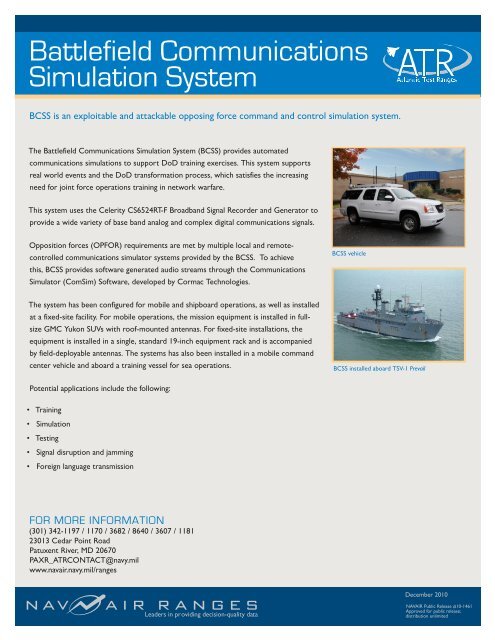Battlefield Communications Simulation System - NAVAIR
Battlefield Communications Simulation System - NAVAIR
Battlefield Communications Simulation System - NAVAIR
You also want an ePaper? Increase the reach of your titles
YUMPU automatically turns print PDFs into web optimized ePapers that Google loves.
<strong>Battlefield</strong> <strong>Communications</strong><br />
<strong>Simulation</strong> <strong>System</strong><br />
BCSS is an exploitable and attackable opposing force command and control simulation system.<br />
The <strong>Battlefield</strong> <strong>Communications</strong> <strong>Simulation</strong> <strong>System</strong> (BCSS) provides automated<br />
communications simulations to support DoD training exercises. This system supports<br />
real world events and the DoD transformation process, which satisfies the increasing<br />
need for joint force operations training in network warfare.<br />
This system uses the Celerity CS6524RT-F Broadband Signal Recorder and Generator to<br />
provide a wide variety of base band analog and complex digital communications signals.<br />
Opposition forces (OPFOR) requirements are met by multiple local and remotecontrolled<br />
communications simulator systems provided by the BCSS. To achieve<br />
this, BCSS provides software generated audio streams through the <strong>Communications</strong><br />
Simulator (ComSim) Software, developed by Cormac Technologies.<br />
BCSS vehicle<br />
The system has been configured for mobile and shipboard operations, as well as installed<br />
at a fixed-site facility. For mobile operations, the mission equipment is installed in fullsize<br />
GMC Yukon SUVs with roof-mounted antennas. For fixed-site installations, the<br />
equipment is installed in a single, standard 19-inch equipment rack and is accompanied<br />
by field-deployable antennas. The systems has also been installed in a mobile command<br />
center vehicle and aboard a training vessel for sea operations.<br />
BCSS installed aboard TSV-1 Prevail<br />
Potential applications include the following:<br />
• Training<br />
• <strong>Simulation</strong><br />
• Testing<br />
• Signal disruption and jamming<br />
• Foreign language transmission<br />
FOR MORE INFORMATION<br />
(301) 342-1197 / 1170 / 3682 / 8640 / 3607 / 1181<br />
23013 Cedar Point Road<br />
Patuxent River, MD 20670<br />
PAXR_ATRCONTACT@navy.mil<br />
www.navair.navy.mil/ranges<br />
December 2010<br />
Leaders in providing decision-quality data<br />
<strong>NAVAIR</strong> Public Release #10-1461<br />
Approved for public release;<br />
distribution unlimited
<strong>Battlefield</strong> <strong>Communications</strong> <strong>Simulation</strong> <strong>System</strong><br />
BASIC SYSTEM CAPABILITIES<br />
• Fixed, mobile, transportable, shipboard operations<br />
• 19-inch rack mount for multiple system configurations<br />
• Simple and complex modulations<br />
• Pre-programmed scenarios or real-time emissions<br />
• User-controlled or scenario-driven RF generator<br />
• Operates on 120 VAC, 60 Hz<br />
• Frequency range 2 MHz to 2.4 GHz<br />
SUBSYSTEM CAPABILITIES<br />
SIGNAL GENERATOR SUBSYSTEM<br />
• Signal generator subsystem generates low-level simple or<br />
complex modulated radio signals within a selected bandwidth<br />
• Provides simple CW, AM, FM, USB and LSB modulations<br />
• Provides complex CDMA 2000, EDGE, FSK, GSM, IS 136,<br />
IS 95, PM Tone Comb, PSK, Square QAM, Tone Comb and<br />
WCDMA modulations<br />
BCSS field-deployable vehicle<br />
SCENARIO DEVELOPMENT<br />
• ComSim software designed to develop battlefield scenarios<br />
• Text-to-speech engine allows scenario developers to type in<br />
voice content, select the voice gender, and control voice pitch<br />
and speed<br />
• Live human voice can be input via computer microphone<br />
• Waveform audio format (WAV) files can be imported for<br />
transmission<br />
• Text messages with real intelligence can be transmitted via<br />
Morse Code, DTMF and a variety of FSK and PSK modulation<br />
types<br />
• Other complex modulation types use either pseudo-random<br />
or pre-defined bit stream patterns<br />
POWER AMPLIFIER SUBSYSTEM<br />
• Four-band linear power amplifier<br />
• CH1: 2 - 30 MHz, 200 W nom.<br />
• CH2: 30 - 500 MHz, 75 W nom.<br />
• CH3: 500 - 1000 MHz, 75 W nom.<br />
• CH4: 1000 - 2400 MHz, 40 W nom.<br />
• Variable output (up to 15 dB attenuation) to simulate lowerpower<br />
threats<br />
BCSS installed as a Mobile Remote Operations Center (MROC)<br />
ANTENNA SUBSYSTEMS<br />
• Fixed-site Antennas<br />
• 120-60 HF antenna system (2 - 30 MHz)<br />
• HP-3512/VRC VHF/UHF whip antenna (30 - 500 MHz)<br />
• DMA-324 discone antenna (500 MHz - 2.4 GHz)<br />
• 20-032 mobile receive-only scanner antenna<br />
• Mobile Antennas<br />
• 120-49 HF vehicular antenna (2 - 30 MHz)<br />
• GD1813HP vehicular VHF/UHF antenna (30 - 500 MHz)<br />
• HP5250S/VRC vehicular antenna (500 MHz - 2.4 GHz)<br />
• 20-032 mobile receive-only scanner antenna<br />
VEHICLE SYSTEM<br />
• GMC Yukon XL, four-wheel drive, four-door, 2500 SLT<br />
equipped with 5 KW generator and 2 KW invertor<br />
• Equipment mounted in two 20 U racks<br />
• Roof-mounted antennas

















